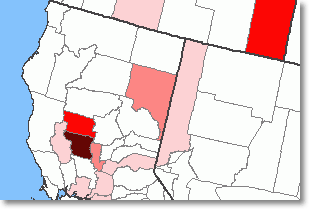| |
Wildlife Mortality Information –
Wildlife Organophosphate/Carbamate Poisoning (OP/CARB) |
What this map layer shows:
The number of bird
deaths due to organophosphate/carbamate poisoning, when each outbreak
occurred, and the top five species affected, by county. |
 |
| Background Information |
 Sample Map
Sample Map
The Wildlife Mortality Information – Wildlife Organophosphate/Carbamate
Poisoning database shows county-level information on wildlife organophosphate/carbamate
poisoning events in the United States, including the dates of each
event, the five top species involved, and the number of deaths. Also
available in the National Atlas are databases describing mortality
events due to avian botulism, avian
cholera, and avian lead poisoning,
as well as a database with county-level counts of
wildlife mortality events. More detailed information on wildlife
organophosphate/carbamate poisoning is available from the Human
Influences chapter of Our Living Resources and from the NWHC Field
Manual of Wildlife Diseases, Chapter 39: Organophosphorus and carbamate
pesticides.
Related Links:
If you download the data for Wildlife Mortality Information – Wildlife
Organophosphate/Carbamate Poisoning (OP/CARB), you may also want to download
the Wildlife Mortality Information – Frequency and the 2001 County
Boundaries data. The Wildlife Mortality frequency information and
the County Boundaries map layers can be used together to create a map
of wildlife mortality that is similar to the map in the Map Maker. The
OP/CARB map layer provides additional information about specific events.
Download Wildlife Mortality
Information – Frequency Data
Download 2001 County Boundaries
|
|
 |
 |
|
|
|
|
